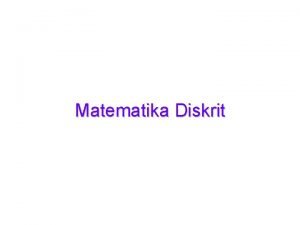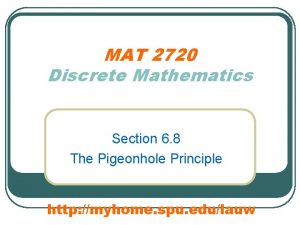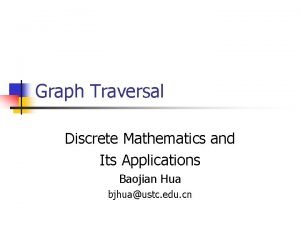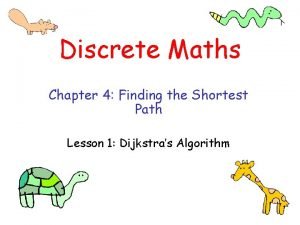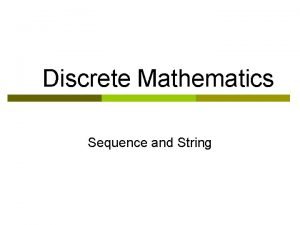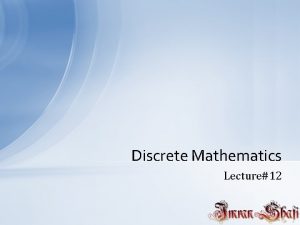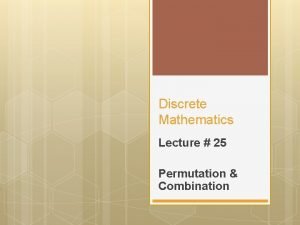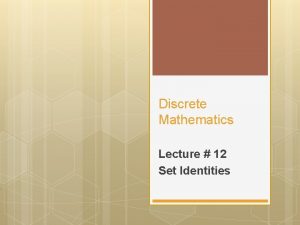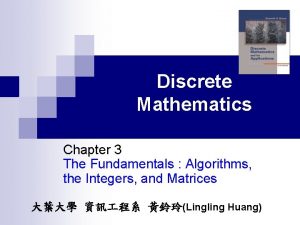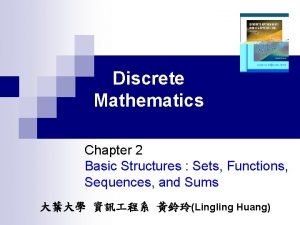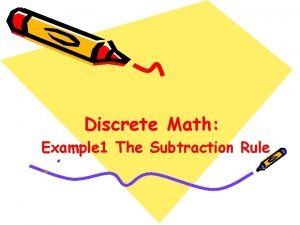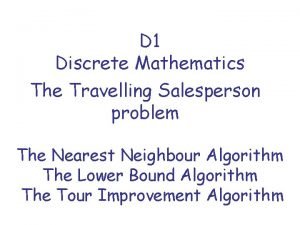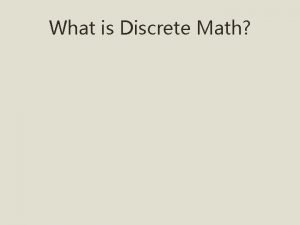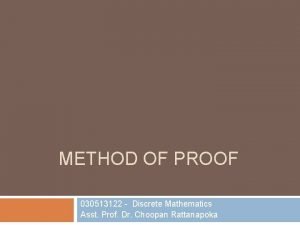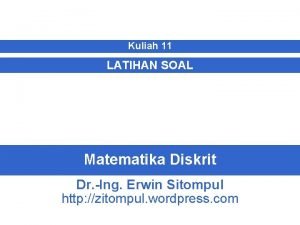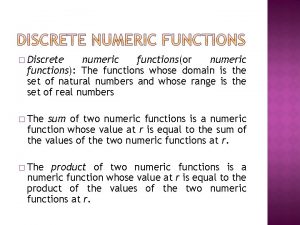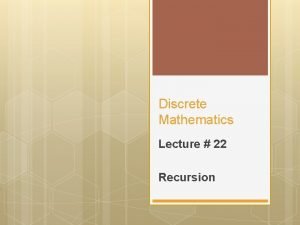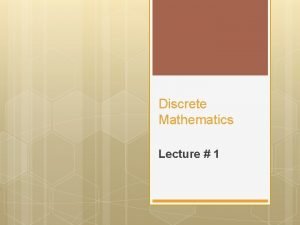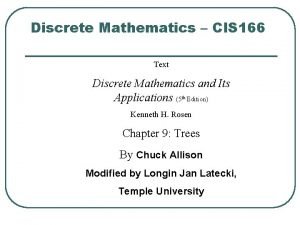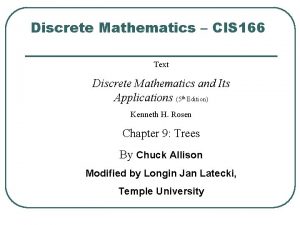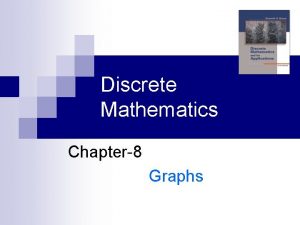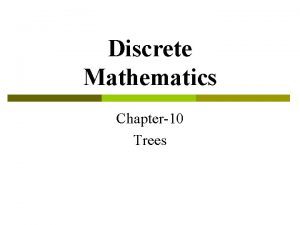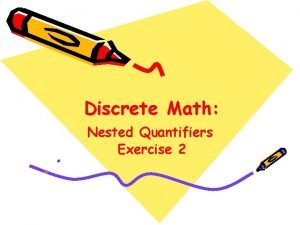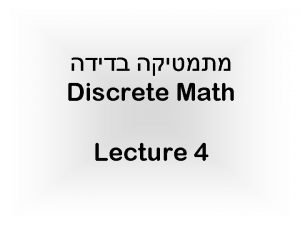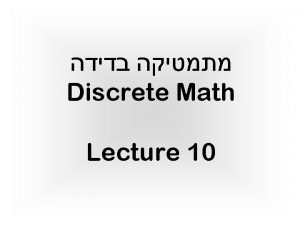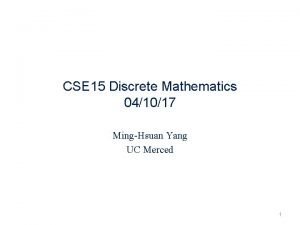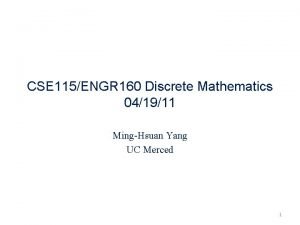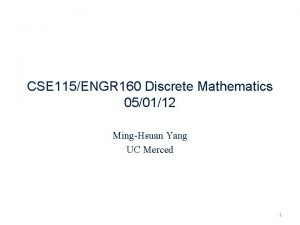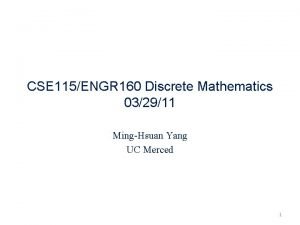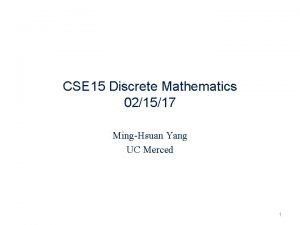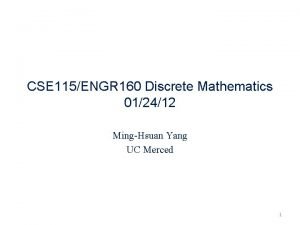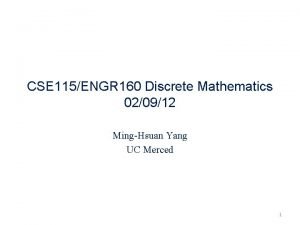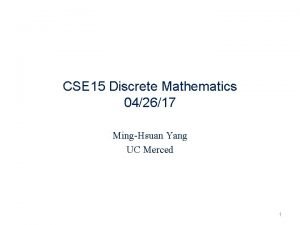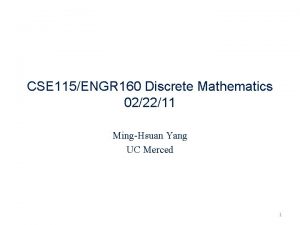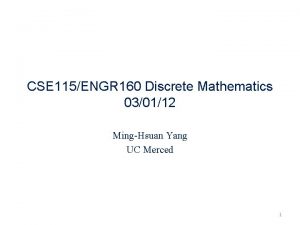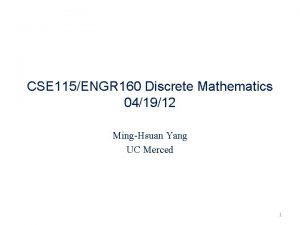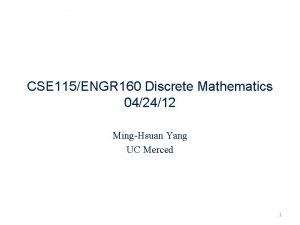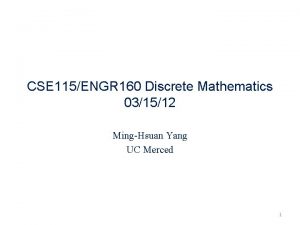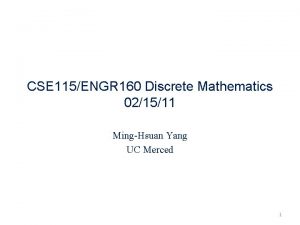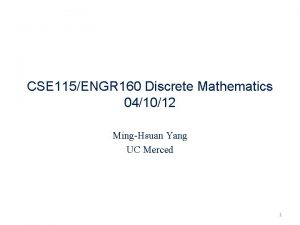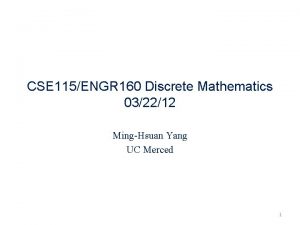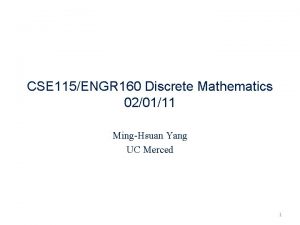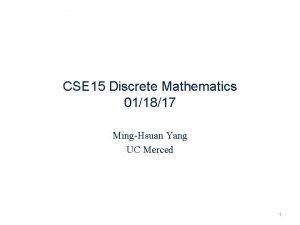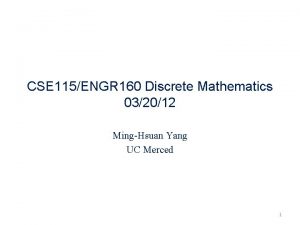CSE 15 Discrete Mathematics 022717 MingHsuan Yang UC

































- Slides: 33

CSE 15 Discrete Mathematics 02/27/17 Ming-Hsuan Yang UC Merced 1

2. 3 One-to-one function • A function f is said to be one-to-one or injective, if and only if f(a)=f(b) implies a=b for all a and b in the domain of f • A function f is one-to-one if and only if f(a)≠f(b) whenever a≠b • Using contrapositive of the implication in the definition (p→q ≡ q whenever p) • Every element of B is the image of a unique element of A 2

Example • f maps {a, b, c, d} to {1, 2, 3, 4, 5} with f(a)=4, f(b)=5, f(c)=1, f(d)=3 • Is f an one-to-one function? 3

Example • Let f(x)=x 2, from the set of integers to the set of integers. Is it one-to-one? • f(1)=1, f(-1)=1, f(1)=f(-1) but 1≠-1 • However, f(x)=x 2 is one-to-one for Z+ • Determine f(x)=x+1 from real numbers to itself is one-to-one or not • It is one-to-one. To show this, note that x+1 ≠ y+1 when x≠y 4

Increasing/decreasing functions • Increasing (decreasing): if f(x)≤f(y) (f(x)≥f(y)), whenever x<y and x, y are in the domain of f • Strictly increasing (decreasing): if f(x)<f(y) (f(x) > f(y)) whenever x<y, and x, y are in the domain of f • A function that is either strictly increasing or decreasing must be one-to-one 5

Onto functions • Onto: A function from A to B is onto or surjective, if and only if for every element b ∈ B there is an element a ∈ A with f(a)=b • Every element of B is the image of some element in A f maps from {a, b, c, d} to {1, 2, 3}, is f onto? 6

Example • Is f(x)=x 2 from the set of integers to the set of integers onto? – f(x)=-1? • Is f(x)=x+1 from the set of integers to the set of integers onto? – It is onto, as for each integer y there is an integer x such that f(x)=y – To see this, f(x)=y iff x+1=y, which holds if and only if x=y-1 7

One-to-one correspondence • The function f is a one-and-one correspondence, or bijective, if it is both oneto-one and onto • Let f be the function from {a, b, c, d} to {1, 2, 3, 4} with f(a)=4, f(b)=2, f(c)=1, and f(d)=3, is f bijective? – It is one-to-one as no two values in the domain are assigned the same function value – It is onto as all four elements of the codomain are images of elements in the domain 8

Example • Identity function: – It is one-to-one and onto 9

Inverse function • Consider a one-to-one correspondence f from A to B • Since f is onto, every element of B is the image of some element in A • Since f is also one-to-one, every element of B is the image of a unique element of A • Thus, we can define a new function from B to A that reverses the correspondence given by f 10

Inverse function • Let f be a one-to-one correspondence from the set A to the set B • The inverse function of f is the function that assigns an element b belonging to B the unique element a in A such that f(a)=b • Denoted by f-1, hence f-1(b)=a when f(a)=b • Note f-1 is not the same as 1/f 11

One-to-one correspondence and inverse function • If a function f is not one-to-one correspondence, cannot define an inverse function of f • A one-to-one correspondence is called invertible 12

Example • f is a function from {a, b, c} to {1, 2, 3} with f(a)=2, f(b)=3, f(c)=1. Is it invertible? What is it its inverse? • Let f: Z→Z such that f(x)=x+1, Is f invertible? If so, what is its inverse? y=x+1, x=y-1, f-1(y)=y-1 • Let f: R→R with f(x)=x 2, Is it invertible? – Since f(2)=f(-2)=4, f is not one-to-one, and so not invertible 13

Example • Sometimes we restrict the domain or the codomain of a function or both, to have an invertible function • The function f(x)=x 2, from R+ to R+ is – one-to-one : If f(x)=f(y), then x 2=y 2, then x+y=0 or x-y=0, so x=-y or x=y – onto: y= x 2, every non-negative real number has a square root – inverse function: 14

Composition of functions • Let g be a function from A to B and f be a function from B to C, the composition of the functions f and g, denoted by f ◦ g, is defined by (f ◦ g)(a)=f(g(a)) – First apply g to a to obtain g(a) – Then apply f to g(a) to obtain (f ◦ g)(a)=f(g(a)) 15

Composition of functions • Note f ◦ g cannot be defined unless the range of g is a subset of the domain of f 16

Example • g: {a, b, c} → {a, b, c}, g(a)=b, g(b)=c, g(c)=a, and f: {a, b, c} →{1, 2, 3}, f(a)=3, f(b)=2, f(c)=1. What are f ◦ g and g ◦ f? • (f◦g)(a)=f(g(a))=f(b)=2, (f◦g)(b)=f(g(b))=f(c)=1, (f◦g)(c)=f(a)=3 • (g◦f)(a)=g(f(a))=g(3) not defined. g◦f is not defined 17

Example f(x)=2 x+3, g(x)=3 x+2. What are f ◦ g and g ◦ f? (f ◦ g)(x)=f(g(x))=f(3 x+2)=2(3 x+2)+3=6 x+7 (g ◦ f)(x)=g(f(x))=g(2 x+3)=3(2 x+3)+2=6 x+11 Note that f ◦ g and g ◦ f are defined in this example, but they are not equal • The commutative law does not hold for composition of functions • • 18

f and f-1 form an identity function in any order Let f: A →B with f(a)=b Suppose f is one-to-one correspondence from A to B Then f-1 is one-to-one correspondence from B to A The inverse function reverses the correspondence of f, so f-1(b)=a when f(a)=b, and f(a)=b when f-1(b)=a • (f-1 ◦f)(a)=f-1(f(a))=f-1(b)=a, and • (f ◦ f-1 )(b)=f(f-1 )(b))=f(a)=b • • • 19

Graphs of functions • Associate a set of pairs in A x B to each function from A to B • The set of pairs is called the graph of the function: {(a, b)|a∈A, b ∈ B, and f(a)=b} f(x)=2 x+1 f(x)=x 2 20

Example 21

Floor and ceiling functions

Proving properties of functions Example: Prove that x is a real number, then ⌊2 x⌋= ⌊x⌋ + ⌊x + 1/2⌋ Solution: Let x = n + ε, where n is an integer and 0 ≤ ε< 1. Case 1: ε < ½ – 2 x = 2 n + 2ε and ⌊2 x⌋ = 2 n, since 0 ≤ 2ε< 1. – ⌊x + 1/2⌋ = n, since x + ½ = n + (1/2 + ε ) and 0 ≤ ½ +ε < 1. – Hence, ⌊2 x⌋ = 2 n and ⌊x⌋ + ⌊x + 1/2⌋ = n + n = 2 n. Case 2: ε ≥ ½ – 2 x = 2 n + 2ε = (2 n + 1) +(2ε − 1) and ⌊2 x⌋ =2 n + 1, since 0 ≤ 2 ε - 1< 1. – ⌊x + 1/2⌋ = ⌊ n + (1/2 + ε)⌋ = ⌊ n + 1 + (ε – 1/2)⌋ = n + 1 since 0 ≤ ε – 1/2< 1. – Hence, ⌊2 x⌋ = 2 n + 1 and ⌊x⌋ + ⌊x + 1/2⌋ = n + (n + 1) = 2 n + 1.

Factorial function Definition: f: N → Z+ , denoted by f(n) = n! is the product of the first n positive integers when n is a nonnegative integer. f(n) = 1 ∙ 2 ∙∙∙ (n – 1) ∙ n, f(0) = 0! = 1 Examples: f(1) = 1! = 1 f(2) = 2! = 1 ∙ 2 = 2 f(6) = 6! = 1 ∙ 2 ∙ 3∙ 4∙ 5 ∙ 6 = 720 f(20) = 2, 432, 902, 008, 176, 640, 000. Stirling’s Formula:

2. 4 Sequences • Ordered list of elements – e. g. , 1, 2, 3, 5, 8 is a sequence with 5 elements – 1, 3, 9, 27, 81, …, 30, …, is an infinite sequence • Sequence {an}: a function from a subset of the set of integers (usually either the set of {0, 1, 2, …} or the set {1, 2, 3, …}) to a set S • Use an to denote the image of the integer n • Call an a term of the sequence 25

Sequences • Example: {an} where an=1/n – a 1 , a 2 , a 3 , a 4 , … – 1, ½, 1/3, ¼, … 26

Geometric progression • Geometric progression: a sequence of the form a, ar 2, ar 3, …, arn where the initial term a and common ratio r are real numbers • Can be written as f(x)=a ∙ rx • The sequences {bn} with bn=(-1)n, {cn} with cn=2∙ 5 n, {dn} with dn=6 ∙(1/3)n are geometric progression – bn : 1, -1, 1, … – cn: 2, 10, 50, 250, 1250, … – dn: 6, 2, 2/3, 2/9, 2/27, … 27

Arithmetic progression • Arithmetic progression: a sequence of the form a, a+d, a+2 d, …, a+nd where the initial term a and the common difference d are real numbers • Can be written as f(x)=a+dx • {sn} with sn=-1+4 n, {tn} with tn=7 -3 n – {sn}: -1, 3, 7, 11, … – {tn}: 7, 4, 1, 02, … 28

String • Sequences of the form a 1, a 2, …, an are often used in computer science • These finite sequences are also called strings • The length of the string S is the number of terms • The empty string, denoted by �� , is the string has no terms 29

Example • Show the set of all integers is countable • We can list all integers in a sequence by 0, 1, 1, 2, -2, … • Or f(n)=n/2 when n is even and f(n)=-(n-1)/2 when n is odd (n=1, 2, 3, …) 30

Example • Is the set of positive rational numbers countable? • Every positive rational number is p/q • First consider p+q=2, then p+q=3, p+q=4, … 1, ½, 2, 3, 1/3, ¼, 2/3, 3/2, 4, 5, … Because all positive rational numbers are listed once, the set is countable 31

Example • Is the set of real numbers uncountable? • Proof by contradiction • Suppose the set is countable, then the subset of all real numbers that fall between 0 and 1 would be countable (as any subset of a countable set is also countable) • The real numbers can then be listed in some order, say, r 1, r 2, r 3, … 32

Example • So • Form a new real number with • Every real number has a unique decimal expansion • The real number r is not equal to r 1, r 2, … as its decimal expansion of ri in the i-th place differs from others • So there is a real number between 0 and 1 that is not in the list • So the assumption that all real numbers can between 0 and 1 can be listed must be false • So all the real numbers between 0 and 1 cannot be listed • The set of real numbers between 0 and 1 is uncountable 33
 Rosen discrete mathematics solutions
Rosen discrete mathematics solutions Pigeonhole principle in discrete mathematics
Pigeonhole principle in discrete mathematics What is tautology in math
What is tautology in math Kesetaraan logis
Kesetaraan logis Tree traversal in discrete mathematics
Tree traversal in discrete mathematics Dijkstra's algorithm in discrete mathematics
Dijkstra's algorithm in discrete mathematics Sequences discrete math
Sequences discrete math What is tautology in math
What is tautology in math Inverse in discrete mathematics
Inverse in discrete mathematics Application of propositional logic
Application of propositional logic Permutation and combination in discrete mathematics
Permutation and combination in discrete mathematics Set identities exercises
Set identities exercises Boolean functions in discrete mathematics
Boolean functions in discrete mathematics Advanced counting techniques in discrete mathematics
Advanced counting techniques in discrete mathematics Discrete mathematics chapter 3 solutions
Discrete mathematics chapter 3 solutions Onto function definition
Onto function definition Discrete math chapter 1 review
Discrete math chapter 1 review Duality in discrete mathematics
Duality in discrete mathematics Incidence matrix in discrete mathematics
Incidence matrix in discrete mathematics Subtraction rule example
Subtraction rule example Travelling salesman problem discrete mathematics
Travelling salesman problem discrete mathematics What is discrete math
What is discrete math Pqqpq
Pqqpq Latihan soal matematika diskrit
Latihan soal matematika diskrit The domain of discrete numeric function is
The domain of discrete numeric function is What is recursion in discrete mathematics
What is recursion in discrete mathematics Compound statement symbols
Compound statement symbols M ary tree in discrete mathematics
M ary tree in discrete mathematics M ary tree in discrete mathematics
M ary tree in discrete mathematics Isomorphism graph
Isomorphism graph What is rooted tree in discrete mathematics
What is rooted tree in discrete mathematics Nested quantifiers exercises
Nested quantifiers exercises What does onto mean in discrete math
What does onto mean in discrete math Binary relation
Binary relation
